The diversity of animals around the world captures the attention of people young and old. The books in this week’s column invite readers to learn about the characteristics and behaviors of various animals that populate the land, sea, and sky and to consider their relationships with humans.
Ages 4–8
Inky’s Amazing Escape: How a Very Smart Octopus Found His Way Home. Sy Montgomery. Ill. Amy Schimler-Safford. 2018. Paula Wiseman/Simon & Schuster.
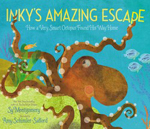 Naturalist Sy Montgomery shares her love for the octopus in this delightful picture book based on the true story of Inky, a young octopus who proved to be an escape artist. Found in a fisherman’s lobster trap, Inky was donated to the National Aquarium in Wellington, New Zealand, where he lived for several years before escaping from his tank and finding a way back to the ocean through a drain in the floor. Amy Schimler-Safford’s whimsical mixed-media illustrations capture the sense of mischievous fun that Montgomery uses to characterize curious Inky. Back matter includes an endnote on the escapes of Inky and other octopuses, eight “fun facts” about the octopus, a bibliography, and links to news articles and video clips about Inky’s escape.
Naturalist Sy Montgomery shares her love for the octopus in this delightful picture book based on the true story of Inky, a young octopus who proved to be an escape artist. Found in a fisherman’s lobster trap, Inky was donated to the National Aquarium in Wellington, New Zealand, where he lived for several years before escaping from his tank and finding a way back to the ocean through a drain in the floor. Amy Schimler-Safford’s whimsical mixed-media illustrations capture the sense of mischievous fun that Montgomery uses to characterize curious Inky. Back matter includes an endnote on the escapes of Inky and other octopuses, eight “fun facts” about the octopus, a bibliography, and links to news articles and video clips about Inky’s escape.
—JS
Little Whale. Jo Weaver. 2018. Peachtree.
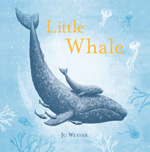 With gentle text and beautiful monochromatic artwork done in charcoal, author/illustrator Jo Weaver tells the tale of Gray Whale and her baby, Little Whale, as they journey from the warm southern seas to the cool waters of the North. Readers will relate to Little Whale’s mixed feelings of uncertainty, wonder, and fear during the migration. With Gray Whale’s nudging and encouragement, Little Gray swims through kelp forests, over coral reefs, and through dark ocean waters until finally they hear the welcome-home song of their pod of gray whales. Reading this engaging fictional story to young children is the perfect introduction to learning more about the long annual migration made by gray whales to breeding grounds in the warm waters of Mexico in the late autumn and their return to feeding grounds in the Arctic seas in the spring.
With gentle text and beautiful monochromatic artwork done in charcoal, author/illustrator Jo Weaver tells the tale of Gray Whale and her baby, Little Whale, as they journey from the warm southern seas to the cool waters of the North. Readers will relate to Little Whale’s mixed feelings of uncertainty, wonder, and fear during the migration. With Gray Whale’s nudging and encouragement, Little Gray swims through kelp forests, over coral reefs, and through dark ocean waters until finally they hear the welcome-home song of their pod of gray whales. Reading this engaging fictional story to young children is the perfect introduction to learning more about the long annual migration made by gray whales to breeding grounds in the warm waters of Mexico in the late autumn and their return to feeding grounds in the Arctic seas in the spring.
—SH
A Pandemonium of Parrots and Other Animals. Ill. Hui Skipp. 2018. Big Picture/Candlewick.
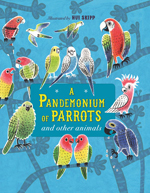 This book about the collective names of 13 animals—from a company of angelfish to an ambush of tigers—offers an engaging interactive reading experience for young readers. Each double-page spread features brightly colored portraits of a variety of individuals and a four-line verse of rhyming couplets about the animal. For example, the spread for a lounge of lizards includes “Casually they lie around, / slouched on rocks or on the ground. / Suddenly one spots its prey, / and in a flash, it darts away.” Questions scattered on the pages (such as “Who’s the smallest?” and “Who’s catching a fly?” in the case of the lizards) add a search-and-find element. Back matter includes a “Did You See?” section that prompts rereading and a “Who’s Who” section with a brief paragraph about each animal.
This book about the collective names of 13 animals—from a company of angelfish to an ambush of tigers—offers an engaging interactive reading experience for young readers. Each double-page spread features brightly colored portraits of a variety of individuals and a four-line verse of rhyming couplets about the animal. For example, the spread for a lounge of lizards includes “Casually they lie around, / slouched on rocks or on the ground. / Suddenly one spots its prey, / and in a flash, it darts away.” Questions scattered on the pages (such as “Who’s the smallest?” and “Who’s catching a fly?” in the case of the lizards) add a search-and-find element. Back matter includes a “Did You See?” section that prompts rereading and a “Who’s Who” section with a brief paragraph about each animal.
—SH
The Secret Life of the Little Brown Bat. Laurence Pringle. Ill. Kate Garchinsky. 2018. Boyds Mills/Highlights.
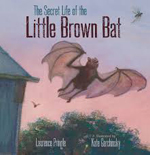 Laurence Pringle’s latest book in his Secret Life Of series, with beautiful realistic illustrations, rendered in pastels and aqua crayons on sanded paper, by Kate Garchinsky, follows one year in the life of a little brown bat named Otis. Vocabulary related to the characteristics and behavior of the little brown bat such as echolocation, hibernation, and nursery colony is introduced in context in the accessible text. Back matter includes a glossary of terms highlighted in italics in the text and an author’s note with additional information on the little brown bat (Myotis lucifugus) and other bats, including the recent decline in bat populations due to white-nose syndrome, a fungal disease.
Laurence Pringle’s latest book in his Secret Life Of series, with beautiful realistic illustrations, rendered in pastels and aqua crayons on sanded paper, by Kate Garchinsky, follows one year in the life of a little brown bat named Otis. Vocabulary related to the characteristics and behavior of the little brown bat such as echolocation, hibernation, and nursery colony is introduced in context in the accessible text. Back matter includes a glossary of terms highlighted in italics in the text and an author’s note with additional information on the little brown bat (Myotis lucifugus) and other bats, including the recent decline in bat populations due to white-nose syndrome, a fungal disease.
—JS
The Squirrels’ Busy Year (A First Science Storybook). Martin Jenkins. Ill. Richard Jones. 2018. Candlewick.
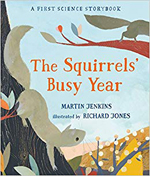 Martin Jenkins’ spare, lyrical text (“Down the trunk . . . / over to the stump . . . / a quick dig, and yes! / Some acorns.”) and Richard Jones’ beautifully-composed mixed media illustrations invite young readers to explore a year in the lives of two gray squirrels. Descriptions of weather conditions through the seasons—beginning in winter and ending in late fall as winter is again approaching—help readers understand the changes in the squirrels’ behavior during their busy year. An introductory note mentions concepts related to why there are seasons that adults may want to discuss with young children as this narrative informational book is read to them. Back matter includes a “Thinking About Seasons and Weather” section of questions and a simple activity and an index.
Martin Jenkins’ spare, lyrical text (“Down the trunk . . . / over to the stump . . . / a quick dig, and yes! / Some acorns.”) and Richard Jones’ beautifully-composed mixed media illustrations invite young readers to explore a year in the lives of two gray squirrels. Descriptions of weather conditions through the seasons—beginning in winter and ending in late fall as winter is again approaching—help readers understand the changes in the squirrels’ behavior during their busy year. An introductory note mentions concepts related to why there are seasons that adults may want to discuss with young children as this narrative informational book is read to them. Back matter includes a “Thinking About Seasons and Weather” section of questions and a simple activity and an index.
—SH
Wild Orca: The Oldest, Wisest Whale in the World. Brenda Peterson. Ill. Wendell Minor. 2018. Christy Ottaviano/Henry Holt.
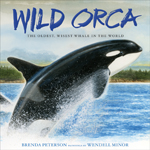 On the longest day of the year, a young girl named Mia is on a whale-watching mission with her family in the San Juan Islands off the coast of Washington. Annually, faithful whale watchers eagerly await the arrival of Granny—the matriarch of a superpod of orcas migrating along the Pacific Northwest—and the new calves. Information about orca family structure and communication is placed within the context of the story. Wendell Minor’s illustrations, rendered in gouache watercolor, express the excitement of the day and present majestic images of the orcas. An author’s note provides additional information about Granny (who was believed to be 105 years old the last time she was spotted in 2016) and encourages protection of the orcas in their natural environment.
On the longest day of the year, a young girl named Mia is on a whale-watching mission with her family in the San Juan Islands off the coast of Washington. Annually, faithful whale watchers eagerly await the arrival of Granny—the matriarch of a superpod of orcas migrating along the Pacific Northwest—and the new calves. Information about orca family structure and communication is placed within the context of the story. Wendell Minor’s illustrations, rendered in gouache watercolor, express the excitement of the day and present majestic images of the orcas. An author’s note provides additional information about Granny (who was believed to be 105 years old the last time she was spotted in 2016) and encourages protection of the orcas in their natural environment.
—JS
Ages 9–11
Hawk Rising. Maria Gianferrari. Ill. Brian Floca. 2018. Roaring Brook.
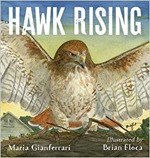 A young birdwatcher watches as a hawk family wakes up. Mother Hawk stays with the young chicks while Father Hawk prepares for the hunt. Missed opportunities and obstacles prolong Father Hawk’s hunt as a chipmunk scuttles away, crows force him away from his perch, and sparrows shield themselves in brambles. Finally, a squirrel is spotted, and Father Hawk “parachutes. Legs tipping, talons gripping . . . and grabbing” and return to the nest with his prey. The imagery of the lyrical text created by Maria Gianferrari’s use of alliteration (“drying drops of dew” and “darting and diving, driving”) and vivid verbs (jostle, charge, thrash, scurry) is complemented by Brian Floca’s stunning realistic watercolor illustrations. Back matter includes facts about red-tailed hawks, suggestions for additional reading, and links to related websites.
A young birdwatcher watches as a hawk family wakes up. Mother Hawk stays with the young chicks while Father Hawk prepares for the hunt. Missed opportunities and obstacles prolong Father Hawk’s hunt as a chipmunk scuttles away, crows force him away from his perch, and sparrows shield themselves in brambles. Finally, a squirrel is spotted, and Father Hawk “parachutes. Legs tipping, talons gripping . . . and grabbing” and return to the nest with his prey. The imagery of the lyrical text created by Maria Gianferrari’s use of alliteration (“drying drops of dew” and “darting and diving, driving”) and vivid verbs (jostle, charge, thrash, scurry) is complemented by Brian Floca’s stunning realistic watercolor illustrations. Back matter includes facts about red-tailed hawks, suggestions for additional reading, and links to related websites.
—SH
Magnificent Birds. Ill. Narisa Togo. 2018. Candlewick Studio/Candlewick.
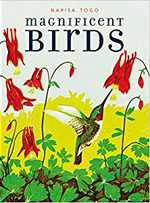 This beautifully designed, oversized book introduces readers to 14 birds from around the world, including the bald eagle from North America, the Andean flamingo from South America, the greater bird of paradise from Indonesia and Papua New Guinea, and the kakapo from New Zealand. Each double-page spread features a colorful lino-cut illustration of a bird in its natural habitat and a block of text with the bird’s common name, scientific name, native region, and one to two paragraphs on its characteristics and behavior, including facts about what makes the bird particularly unusual and “magnificent.”
This beautifully designed, oversized book introduces readers to 14 birds from around the world, including the bald eagle from North America, the Andean flamingo from South America, the greater bird of paradise from Indonesia and Papua New Guinea, and the kakapo from New Zealand. Each double-page spread features a colorful lino-cut illustration of a bird in its natural habitat and a block of text with the bird’s common name, scientific name, native region, and one to two paragraphs on its characteristics and behavior, including facts about what makes the bird particularly unusual and “magnificent.”
—JS
Ages 12–14
The Great Rhino Rescue: Saving the Southern White Rhinos. Sandra Markle. 2018. Millbrook/Lerner.
 In her latest animal rescue text, Sandra Markle informs readers of the plight of the Southern white rhinoceros—a mammal believed to be extinct in the 1800s due to overhunting for sport and loss of its savanna habitat to farming. Although a small group (less than 100) of the mammals was discovered in South Africa in 1895, the numbers of white rhino remains small today—around 20,000—and the species faces a new threat from illegal poaching for their much sought-after horns. The high-interest text provides background on the conservation status of the rhinoceros over the years as well as current efforts to save the species from extinction. Nonfiction text features include a table of contents, heading/subheadings, numerous captioned full-color photographs, sidebars of related information, an author’s note, a timeline, a glossary, an index, and additional resources (books and websites) for readers to explore.
In her latest animal rescue text, Sandra Markle informs readers of the plight of the Southern white rhinoceros—a mammal believed to be extinct in the 1800s due to overhunting for sport and loss of its savanna habitat to farming. Although a small group (less than 100) of the mammals was discovered in South Africa in 1895, the numbers of white rhino remains small today—around 20,000—and the species faces a new threat from illegal poaching for their much sought-after horns. The high-interest text provides background on the conservation status of the rhinoceros over the years as well as current efforts to save the species from extinction. Nonfiction text features include a table of contents, heading/subheadings, numerous captioned full-color photographs, sidebars of related information, an author’s note, a timeline, a glossary, an index, and additional resources (books and websites) for readers to explore.
—JS
The Hyena Scientist (Scientists in the Field). Sy Montgomery. Ill. Nic Bishop. 2018. Houghton Mifflin.
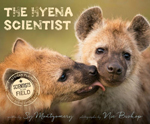 In their latest book in the Scientists in the Field series, naturalist/ author Sy Montgomery and biologist /photographer Nic Bishop challenge popular negative perceptions of hyenas by shadowing zoologist Kay Holekamp and her research team at Camp Fisi in Masai Mara, Kenya. Readers will feel like they are along on the adventurous 10-day visit as they enjoy Montgomery’s account of observations and experiences working with the researchers and Bishop’s close-up photographs of the spotted hyena. Sidebars present stories of the team members’ educational journeys to this line of animal research. Back matter includes “Fast Facts” about the spotted hyena’s habitat, diet, breeding, relatives, and more; a bibliography; acknowledgments; and an index.
In their latest book in the Scientists in the Field series, naturalist/ author Sy Montgomery and biologist /photographer Nic Bishop challenge popular negative perceptions of hyenas by shadowing zoologist Kay Holekamp and her research team at Camp Fisi in Masai Mara, Kenya. Readers will feel like they are along on the adventurous 10-day visit as they enjoy Montgomery’s account of observations and experiences working with the researchers and Bishop’s close-up photographs of the spotted hyena. Sidebars present stories of the team members’ educational journeys to this line of animal research. Back matter includes “Fast Facts” about the spotted hyena’s habitat, diet, breeding, relatives, and more; a bibliography; acknowledgments; and an index.
—SH
Ages 15+
Animals Go to War: From Dogs to Dolphins. Connie Goldsmith. 2018. Twenty-First Century/Lerner.
 The opening story of this fascinating book about a brave dog named Judy, who was an official Prisoner of War during World War II, provides the reader with an initial understanding of the important role animals play in wartime. Subsequent chapters focus on other animals (including elephants, pigeons, and horses) that go to war. After readers gain a better understanding of how animals are currently being trained in support of troops, they will be able to thoughtfully defend a position on whether or not they think animals should be used in battle. Back matter includes source notes, a glossary, an index, a selected bibliography, and other resources for further exploration of this interesting topic.
The opening story of this fascinating book about a brave dog named Judy, who was an official Prisoner of War during World War II, provides the reader with an initial understanding of the important role animals play in wartime. Subsequent chapters focus on other animals (including elephants, pigeons, and horses) that go to war. After readers gain a better understanding of how animals are currently being trained in support of troops, they will be able to thoughtfully defend a position on whether or not they think animals should be used in battle. Back matter includes source notes, a glossary, an index, a selected bibliography, and other resources for further exploration of this interesting topic.
—JS
Outrageous Animal Adaptations: From Big-eared Bats to Frill-necked Lizards. Michael J. Rosen. 2018. Twenty-First Century/Lerner.
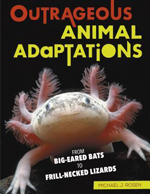 Michael J. Rosen uses a humorous, conversational style of writing to inform and intrigue readers about adaptations of 24 animals, including unfamiliar ones such as the aye-aye and geoduck as well as some odd species of more familiar animals. A table of contents with attention-grabbing, descriptive titles directs readers to chapters on animals of interest. For example, “Mayan Tapir: A Most Noteworthy Nose” refers the reader to a three-page chapter (presented in a witty fashion) about the tapir, including that the vegetarian tapir’s flexible, trunk-like nose is useful for snatching fallen fruit from the forest floor, grabbing branches of higher foliage—and for sniffing out the urine-marked paths of other territorial tapirs. Chapters include captioned full-color photographs and sidebars of key adaptations, basic information on classification, distribution, and conservation status, and “curious facts” about the animals.
Michael J. Rosen uses a humorous, conversational style of writing to inform and intrigue readers about adaptations of 24 animals, including unfamiliar ones such as the aye-aye and geoduck as well as some odd species of more familiar animals. A table of contents with attention-grabbing, descriptive titles directs readers to chapters on animals of interest. For example, “Mayan Tapir: A Most Noteworthy Nose” refers the reader to a three-page chapter (presented in a witty fashion) about the tapir, including that the vegetarian tapir’s flexible, trunk-like nose is useful for snatching fallen fruit from the forest floor, grabbing branches of higher foliage—and for sniffing out the urine-marked paths of other territorial tapirs. Chapters include captioned full-color photographs and sidebars of key adaptations, basic information on classification, distribution, and conservation status, and “curious facts” about the animals.
—SH
Jennifer W. Shettel is an associate professor at Millersville University of Pennsylvania, where she teaches undergraduate and graduate courses in literacy. Prior to joining the faculty at Millersville, she spent 16 years as an elementary classroom teacher and reading specialist in the public schools. Skye Hisiro is an elementary classroom teacher in Harrisburg, Pennsylvania, and is a recent graduate from Pennsylvania State Harrisburg’s Masters in Literacy Education Program.
These reviews are submitted by members of the International Literacy Association's Children's Literature and Reading Special Interest Group (CL/R SIG) and are published weekly on Literacy Daily.